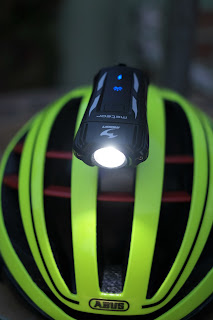Little n’ often is the way when it comes to winter maintenance. Many problems can be swerved, simply by keeping bikes clean and lightly lubricated. Brush tyres down to remove sharps before they can burrow into the casing and cause flats, remove grit from brake pads, wipe the chain’s side plates, especially if you’re running a wet lube. Mudguards (fenders) and big flaps, such as these RAW https://www.sevendaycyclist.com/raw-prismatic also offer considerable protection to bike and rider alike.
The Zefal Extreme Wet
(Ceramic) is proving reassuringly stoical-filmy given 325miles or so but on a
derailleur set up, the chain reclaims the excess coting the cassette. I noted
the indexing had gone slightly off. Cable tension tweak-sorted.
Funny how things can be
textbook perfect on the workstand, yet prove out, on the road/trail. Zoned in,
I also turned my attention to the brakes since regularly tackling waterlogged
roads sees brakes and other mechanisms coated in dodgy, grimy stuff. This can gum
things up, causing the brake arm to drag/stick. The front Genetic CX Cantilevers
https://www.sevendaycyclist.com/genetic-cx-cantilever-brakes are
great stoppers but needed a quick bit of TLC. Balance screws tweaked, I gave
the screws, springs and inner cable a quick shot of heavy-duty maintenance
spray, which has brought stopping back up to scratch.
Braking sorted; the Schwalbe
Kojak grip the wet, mushy leaf carpeted lanes like the proverbial leach. I have
finally retired the rear Continental Contact Speed Reflex https://www.sevendaycyclist.com/continental-contact-speed-reflex-ty due to a succession
of small but rather deep, sharp induced gashes. Thankfully, Monday morning’s
puncture proved a slow affair that struck less than 5 minutes from base.
I was aware of a faint hiss
but put it down to the swoosh as we glided through the puddles. Any loss of
pressure was undetectable until several hours later, when I noticed the rear
was sitting pancake flat on the lino floor protector. Aside from being quick
rolling and grippy, there’s no tread to catch glass, thorns and flints.
However, slicks with very
supple casings are more vulnerable to cuts. Brush them down regularly-Oxford
tyre scrub https://www.sevendaycyclist.com/oxford-products-tyre-scrub is probably the best I’ve used to date (not
surprising, given it’s tyre specific. Some If slicks aren’t your thing,
Schwalbe Marathon Racer might light the spark… https://www.sevendaycyclist.com/schwalbe-marathon-racer-tyres
Elsewhere, Bob Elliot & Co
www.bob-elliot.co.uk have
sent the these FLR Defender Winter Shoes (mtb booties in my book) to test.
Timely, in many respects, since my much-loved Lake finally came to the end of
their life (sole) after ten winters. Talking of which, no winter cycling discussion would be complete without an overview of lighting https://www.sevendaycyclist.com/blank-ypcqd
Road versions would be a more
obvious choice in some respects, but I only use twin bolt pedals these days.
Besides, I want a sporting chance of staying upright when temperatures dip and
winter takes hold. Not so easy to hobble back and forth to your bike with an
exposed Look/pattern cleat.
I’ve switched the long serving
and very likeable Passport Cycles Bike Packing Seat Pack Medium https://www.sevendaycyclist.com/passport-cycles-bikepacking-seat-pa for this Zefal Z Adventure R5. As the name
hints, it’s a 5 litre model (compared with the Passport’s 7) and a simple,
single compartment design, which may prove less convenient. However, it
promises to be waterproof, rather than water-resistant and the simple mounting
system is intuitive. Incredibly secure with zero sway-despite the single strap
and on narrower post diameters.
Elsewhere, despite the present
UK “Lockdown” Town centres seem to bristle with pedestrian traffic and a
surprising number of “non-essential” shops/businesses remain open. Not unexpected,
given the UK government’s consistent mishandling of the pandemic, U-turning and
subsequent loss of public trust. However, in stark contrast to the initial
lockdown, where road traffic fell to 1950s levels.



























